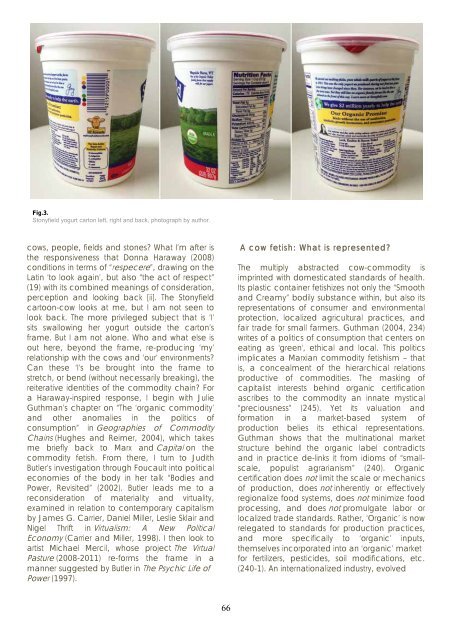Marketing Animals - Antennae The Journal of Nature in Visual Culture
Marketing Animals - Antennae The Journal of Nature in Visual Culture
Marketing Animals - Antennae The Journal of Nature in Visual Culture
You also want an ePaper? Increase the reach of your titles
YUMPU automatically turns print PDFs into web optimized ePapers that Google loves.
Fig.3.<br />
Stonyfield yogurt carton left, right and back, photograph by author.<br />
cows, people, fields and stones? What I’m after is<br />
the responsiveness that Donna Haraway (2008)<br />
conditions <strong>in</strong> terms <strong>of</strong> “respecere”, draw<strong>in</strong>g on the<br />
Lat<strong>in</strong> ‘to look aga<strong>in</strong>’, but also “the act <strong>of</strong> respect”<br />
(19) with its comb<strong>in</strong>ed mean<strong>in</strong>gs <strong>of</strong> consideration,<br />
perception and look<strong>in</strong>g back [ii]. <strong>The</strong> Stonyfield<br />
cartoon-cow looks at me, but I am not seen to<br />
look back. <strong>The</strong> more privileged subject that is ‘I’<br />
sits swallow<strong>in</strong>g her yogurt outside the carton’s<br />
frame. But I am not alone. Who and what else is<br />
out here, beyond the frame, re-produc<strong>in</strong>g ‘my’<br />
relationship with the cows and ‘our’ environments?<br />
Can these ‘I’s be brought <strong>in</strong>to the frame to<br />
stretch, or bend (without necessarily break<strong>in</strong>g), the<br />
reiterative identities <strong>of</strong> the commodity cha<strong>in</strong>? For<br />
a Haraway-<strong>in</strong>spired response, I beg<strong>in</strong> with Julie<br />
Guthman’s chapter on “<strong>The</strong> ‘organic commodity’<br />
and other anomalies <strong>in</strong> the politics <strong>of</strong><br />
consumption” <strong>in</strong> Geographies <strong>of</strong> Commodity<br />
Cha<strong>in</strong>s (Hughes and Reimer, 2004), which takes<br />
me briefly back to Marx and Capital on the<br />
commodity fetish. From there, I turn to Judith<br />
Butler’s <strong>in</strong>vestigation through Foucault <strong>in</strong>to political<br />
economies <strong>of</strong> the body <strong>in</strong> her talk “Bodies and<br />
Power, Revisited” (2002). Butler leads me to a<br />
reconsideration <strong>of</strong> materiality and virtuality,<br />
exam<strong>in</strong>ed <strong>in</strong> relation to contemporary capitalism<br />
by James G. Carrier, Daniel Miller, Leslie Sklair and<br />
Nigel Thrift <strong>in</strong> Virtualism: A New Political<br />
Economy (Carrier and Miller, 1998). I then look to<br />
artist Michael Mercil, whose project <strong>The</strong> Virtual<br />
Pasture (2008-2011) re-forms the frame <strong>in</strong> a<br />
manner suggested by Butler <strong>in</strong> <strong>The</strong> Psychic Life <strong>of</strong><br />
Power (1997).<br />
66<br />
A cow fetish: What is represented?<br />
<strong>The</strong> multiply abstracted cow-commodity is<br />
impr<strong>in</strong>ted with domesticated standards <strong>of</strong> health.<br />
Its plastic conta<strong>in</strong>er fetishizes not only the “Smooth<br />
and Creamy” bodily substance with<strong>in</strong>, but also its<br />
representations <strong>of</strong> consumer and environmental<br />
protection, localized agricultural practices, and<br />
fair trade for small farmers. Guthman (2004, 234)<br />
writes <strong>of</strong> a politics <strong>of</strong> consumption that centers on<br />
eat<strong>in</strong>g as 'green', ethical and local. This politics<br />
implicates a Marxian commodity fetishism – that<br />
is, a concealment <strong>of</strong> the hierarchical relations<br />
productive <strong>of</strong> commodities. <strong>The</strong> mask<strong>in</strong>g <strong>of</strong><br />
capitalist <strong>in</strong>terests beh<strong>in</strong>d organic certification<br />
ascribes to the commodity an <strong>in</strong>nate mystical<br />
“preciousness” (245). Yet its valuation and<br />
formation <strong>in</strong> a market-based system <strong>of</strong><br />
production belies its ethical representations.<br />
Guthman shows that the mult<strong>in</strong>ational market<br />
structure beh<strong>in</strong>d the organic label contradicts<br />
and <strong>in</strong> practice de-l<strong>in</strong>ks it from idioms <strong>of</strong> “smallscale,<br />
populist agrarianism” (240). Organic<br />
certification does not limit the scale or mechanics<br />
<strong>of</strong> production, does not <strong>in</strong>herently or effectively<br />
regionalize food systems, does not m<strong>in</strong>imize food<br />
process<strong>in</strong>g, and does not promulgate labor or<br />
localized trade standards. Rather, ‘Organic’ is now<br />
relegated to standards for production practices,<br />
and more specifically to ‘organic’ <strong>in</strong>puts,<br />
themselves <strong>in</strong>corporated <strong>in</strong>to an ‘organic’ market<br />
for fertilizers, pesticides, soil modifications, etc.<br />
(240-1). An <strong>in</strong>ternationalized <strong>in</strong>dustry, evolved












